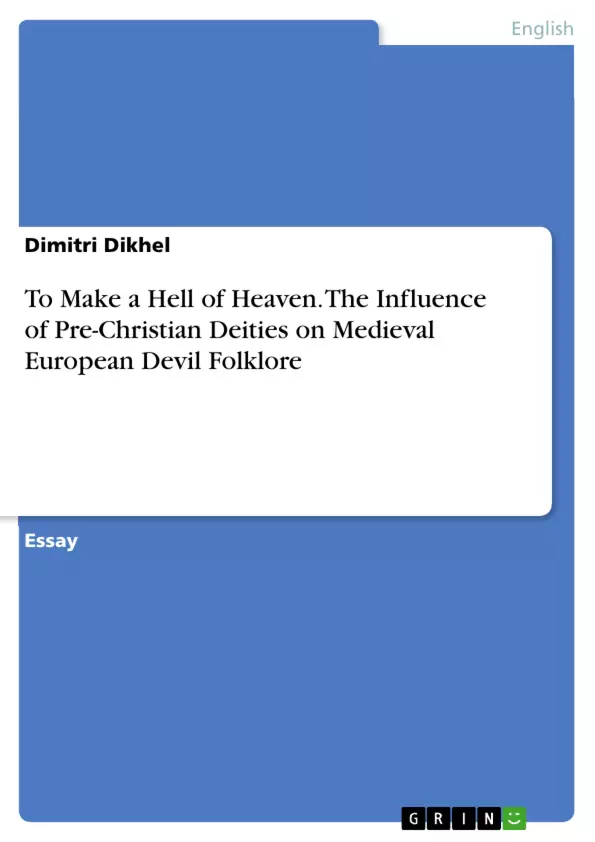In this essay I am going to argue that the medieval perception of the Devil incorporated iconography previously associated with the deities of pre-Christian Europe as part of their demonization under the interpretatio Christiana. While numerous literary portrayals of Satan from that period draw from “heathen” imagery, they do not always exemplify the larger trend of demonizing pagan gods. Although Satan’s tricephalic form in Dante’s Divina Commedia is likely to have been at least partially inspired by the Greek goddess Hecate, for instance, there do not seem to have been enough depictions of the Devil as having three faces to use this as an example of how Hecate was demonized. It is the more prevalent, folkloric portrayals of the Devil with hooves, horns, a forked tongue and carrying a pitchfork, bearing little resemblance to his theological counterpart (cf. Russell, Lucifer), that highlight the interpretatio Christiana of the Germanic Æsir and the Greco-Roman pantheon. As Richard Kiekhefer states in Magic in the Middle Ages (1989), “orthodox opinion” in early medieval Europe “held that pagan religion was no true religion but mere demon-worship”. Thus, while figures such as Loki were imbued with Satanic qualities in later retellings of Norse myths, reinterpreting his shapeshifting and gender-fluidness as a sign of evil, iconography associated with Norse and Greco-Roman gods, such as goat legs, dogs, snakes and tridents, was incorporated into medieval Christian Devil folklore.
Table of Contents
- "To Make a Hell of Heaven" The Influence of Pre-Christian Deities on Medieval European Devil Folklore
Objectives and Key Themes
This essay argues that the medieval depiction of the Devil incorporated iconography previously associated with pre-Christian European deities as part of their demonization under the interpretatio Christiana. The essay examines how literary and folkloric portrayals of Satan adopted imagery from pagan gods, exploring the process of demonization and its cultural implications.
- The interpretatio Christiana and its role in demonizing pre-Christian deities.
- The incorporation of pagan iconography into medieval Christian Devil folklore.
- The use of demonic imagery to discourage non-Christian behavior.
- The persistence of pagan beliefs and their influence on the evolving perception of the Devil.
- The relationship between the Devil's hybridity and the incorporation of pagan symbolism.
Chapter Summaries
"To Make a Hell of Heaven" The Influence of Pre-Christian Deities on Medieval European Devil Folklore: This essay explores how the medieval European conception of the Devil integrated imagery and attributes previously linked to pre-Christian deities. It argues that the process, known as interpretatio Christiana, involved reinterpreting pagan gods and figures as demonic entities to facilitate the Christianization of Europe. The essay examines various examples from literature and folklore, including the portrayal of Satan's physical characteristics (hooves, horns, forked tongue) and the demonization of figures like Loki, demonstrating how pagan iconography became associated with evil in medieval Christian culture. The enduring presence of pagan beliefs in the medieval mind is discussed, highlighting the difficulty of completely erasing pre-existing religious systems and the consequent need to reinterpret rather than simply negate them. The essay also touches upon the use of demonic imagery as a tool to discourage non-Christian practices and maintain social order.
Keywords
Interpretatio Christiana, Medieval Devil Folklore, Pagan Deities, Demonization, Iconography, Loki, Shapeshifting, Gender Fluidity, Cultural Anxiety, Christianization.
Frequently Asked Questions: "To Make a Hell of Heaven" The Influence of Pre-Christian Deities on Medieval European Devil Folklore
What is the main argument of this essay?
The essay argues that the medieval depiction of the Devil incorporated iconography previously associated with pre-Christian European deities as part of their demonization under the interpretatio Christiana. It explores how literary and folkloric portrayals of Satan adopted imagery from pagan gods, analyzing the process of demonization and its cultural implications.
What are the key themes explored in the essay?
Key themes include the interpretatio Christiana and its role in demonizing pre-Christian deities; the incorporation of pagan iconography into medieval Christian Devil folklore; the use of demonic imagery to discourage non-Christian behavior; the persistence of pagan beliefs and their influence on the evolving perception of the Devil; and the relationship between the Devil's hybridity and the incorporation of pagan symbolism.
What specific examples are used to support the essay's argument?
The essay examines various examples from literature and folklore, including the portrayal of Satan's physical characteristics (hooves, horns, forked tongue) and the demonization of figures like Loki, demonstrating how pagan iconography became associated with evil in medieval Christian culture.
How does the essay address the persistence of pagan beliefs in the medieval period?
The essay discusses the enduring presence of pagan beliefs in the medieval mind, highlighting the difficulty of completely erasing pre-existing religious systems and the consequent need to reinterpret rather than simply negate them.
What role did demonic imagery play in medieval society?
The essay touches upon the use of demonic imagery as a tool to discourage non-Christian practices and maintain social order.
What are the key terms or keywords associated with this essay?
Key terms include: Interpretatio Christiana, Medieval Devil Folklore, Pagan Deities, Demonization, Iconography, Loki, Shapeshifting, Gender Fluidity, Cultural Anxiety, Christianization.
What is the overall scope of the essay?
The essay provides a comprehensive overview of how pre-Christian imagery and beliefs were integrated into the medieval European conception of the Devil, focusing on the process of demonization and its cultural significance.
- Quote paper
- Dimitri Dikhel (Author), 2020, To Make a Hell of Heaven. The Influence of Pre-Christian Deities on Medieval European Devil Folklore, Munich, GRIN Verlag, https://www.grin.com/document/958320



